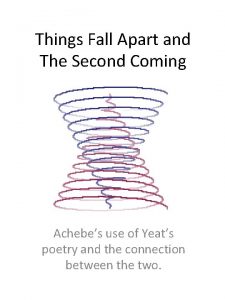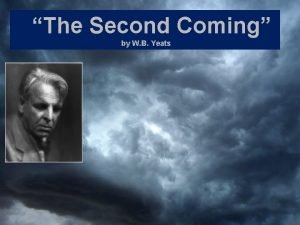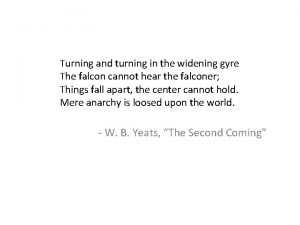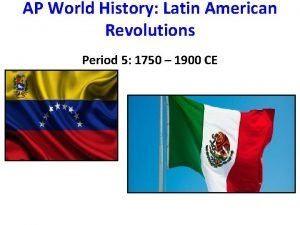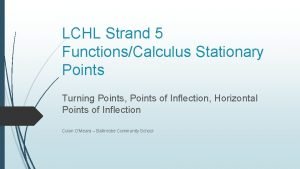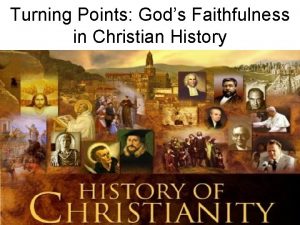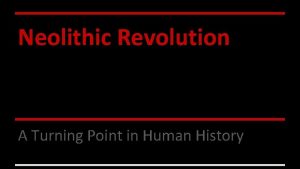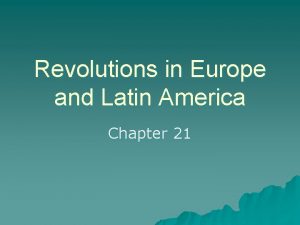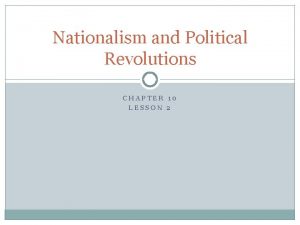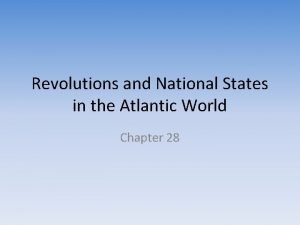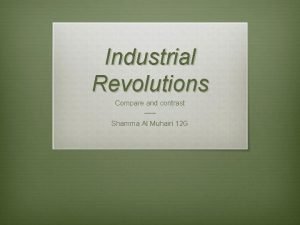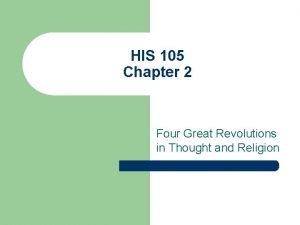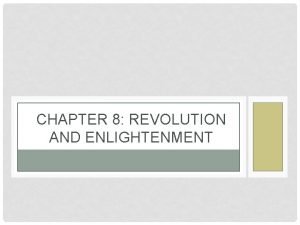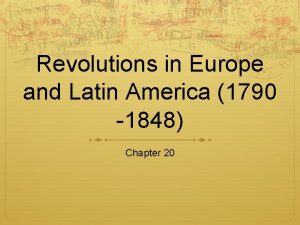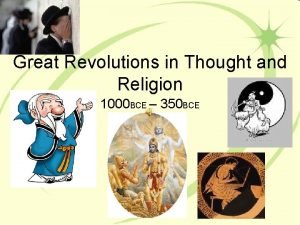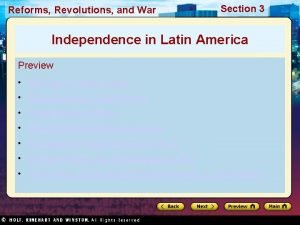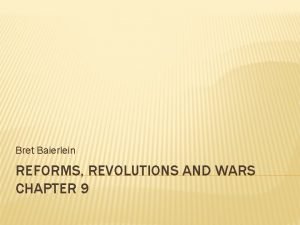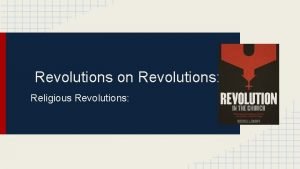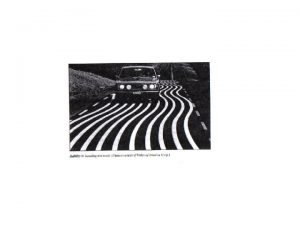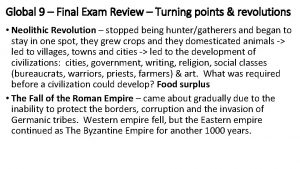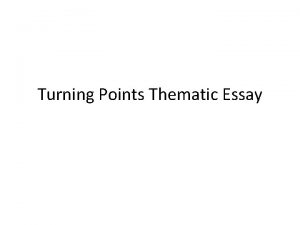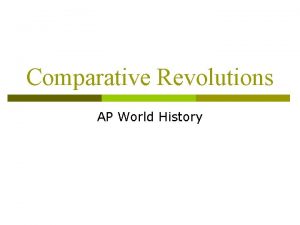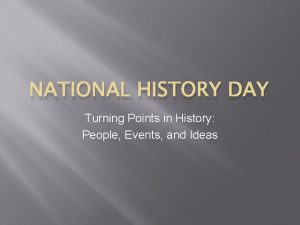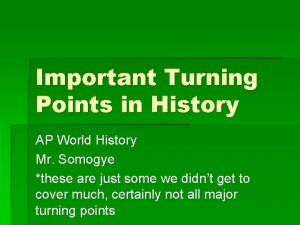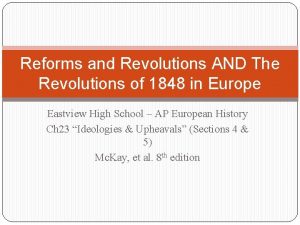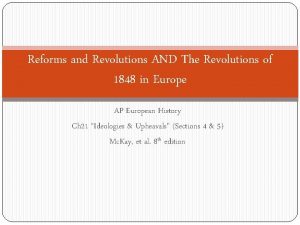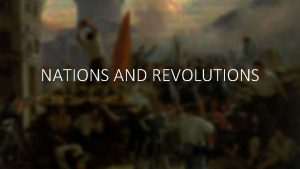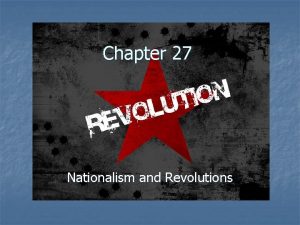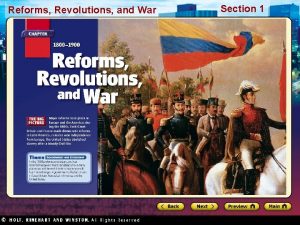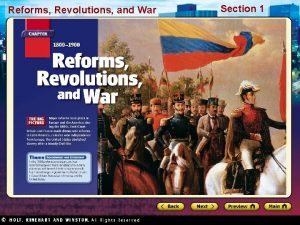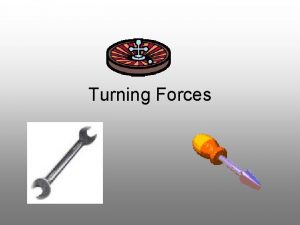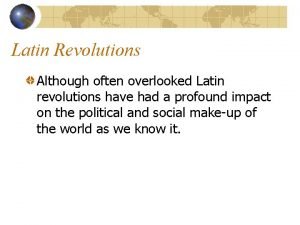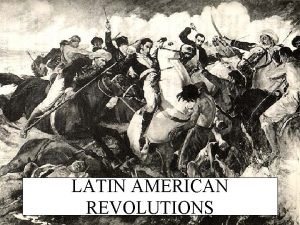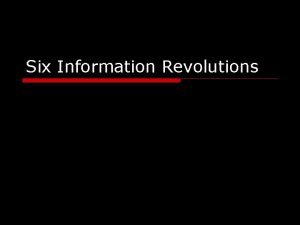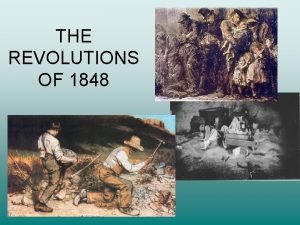Turning Points and Revolutions in History Do you






















- Slides: 22

Turning Points and Revolutions in History Do you know your Turning Points and Revolutions? Turning Point: The point at which a very significant CHANGE occurs Revolutions: A major CHANGE in government, ideas, or society.

Neolithic Revolution Fall of Rome (476 AD) Fall of French Revolution (1789) Constantinople (1453) Europeans Reach New World (1492) Birth of Islam (622 -632) Mongol Conquests (1200 s) Perry’s Arrival in Japan (1853) Russian Revolution (1917) Dropping the Atomic Bomb on Japan (1945) Soviet Union Falls Apart (1991) Commercial Revolution Scientific Revolution Industrial Revolution The Invention of the Printing Press Protestant Reformation Sepoy Mutiny Boxer Rebellion Fall of the Berlin Wall Iranian Revolution

Neolithic Revolution Description: Humans begin farming & domesticating animals The Good: When people have a reliable food source they are able to settle into permanent settlements People stop being nomadic Leads to development of CIVILIZATION

Fall of Rome Description: The Western Roman Empire falls to internal problems and outside invaders In 476, Rome is no longer able to govern Europe The Good: • The Roman Catholic Church holds European culture together • The Church provides social services and preserves knowledge The Bad: • Europe is in chaos/decentralized • Feudalism develops to protect Europeans • Europe is decentralized • Trade in Europe stops The Ugly: • Europe is invaded by Vikings, Muslims, and Magyars • Europeans start living in ISOLATED feudal manors

Birth of Islam Description: Islam is founded by the prophet Muhammad Islam gains popularity and spreads The Good: • Islam unites people of the middle east and north Africa in RELIGION and LANGUAGE (Arabic) • Islam ties people together and creates a rich civilization • Muslims develop algebra and make advances in medicine, calligraphy, and science The Bad: • The Crusades lead to atrocities and tension between Europe and Middle East

Mongol Conquests Description: Mongols conquer a huge empire that spans Europe, Asia, and India. The Good: • Mongols increase trade and stability in the areas between Europe and Asia • World trade increases with PAX MONGOLIA • Europeans become very interested in Asian goods The Bad: • The Mongols take over many civilizations and force them to pay tribute The Ugly: • The Mongols introduce germ warfare • The Mongols kill everyone who doesn’t surrender to them (men, women, children) TERROR

Europeans Reach New World Description: Europeans “discover” and colonize the Americas The Good: • Columbian Exchange – Europe and Americas exchange plants, animals, and disease The Bad: • Ancient Native American Civilizations destroyed (Aztec, Inca, Maya) The Ugly: • Millions of Native Americans die of disease • Atlantic Slave trade brings African slaves to the Americas

Fall of Constantinople Description: The city of Constantinople finally falls to the Ottoman Turks (Muslim Invaders) The Good: • Leads Portugal and Spain to explore new sea routes to Asia The Bad: • Europeans are cut of from Asian Trade The Iffy: • Leads to the eventual colonization of America

The French Revolution The Good: • Challenged the idea of Divine Right of Kings Description: The unfair tax system of the Monarchy in Frances causes • the Bourgeoisie (middle class) to lead a revolution to bring • democratic changes to France • Ends all feudalism in France Political power shifted from the king to the people in France Model for people wanting change in the government The Bad: • European Monarchies declare war on France – leads to Napoleonic wars The Ugly: • The Reign of Terror leads to the execution of 40, 000 “traitors to the revolution”

Perry’s Arrival in Japan The Good: • Ends Japan’s isolation from the world Description: Japan to modernize American Commodore • Causes under Emperor Meiji Perry takes modern fleet • Ends feudalism in Japan and into Tokyo, Japan. Shogun’s power • Japan avoids imperialism by He demands that the modernizing Japanese open their ports to world trade The Bad: • Leads to the end of traditional Japanese culture. • Samurai lose their rights and some fight against the government

Russian Revolution (1917) Description: • Russia is ruled by Czar Nicholas II The Good: • The old unfair social class system is abolished The Bad: • Communism starts to spread to other countries and cause conflict • Food shortages and losses in WWI lead the people to revolt • Lenin/Stalin found single-part totalitarian government against Nicholas • Distrust between Communist • Russian Communist Part states and democratic states leads (BOLSHEVIKS) take over the to COLD WAR Provisional Government Russia becomes COMMUNIST The Ugly: • The Russian people still have NO RIGHTS!!!! • People who disagree with the government are jailed or killed

Dropping the Atomic Bomb on Japan Description: • United States wants to end WWII against Japan quickly • Drops atomic bombs on the cities of Hiroshima and Nagasaki • Japan surrenders/WWII ends The Good: • Ends the war quickly – less Americans killed • Technology leads to the development of nuclear power The Bad: • Introduction of weapons of mass destruction to the world • Leads to mistrust between U. S. and Russia in the Cold War • Wars now have the possibility to end all life on our planet • Leads to nuclear arms races The Ugly: • 220, 000 people in Hiroshima and Nagasaki die instantly due to the blast, by radiation poisoning, or by developing cancer as a result of radiation

The Soviet Union Falls Apart The Good: Description: • Mikhail Gorbachev allows for • The Cold War is over Capitalism (Perestroika) and freedom of speech • Former Soviet Republics are allowed (Glasnost) which leads to the SELF-DETERMINATION end of Communism in the Soviet Union • People are given more rights • Former Soviet Republics declare independence in 1991 The Bad: – Soviet Union no longer exists • Issues involving the security of the Soviets nuclear weapons • Russia fights corruption/mafia The Ugly: • Russia tries to hold onto territory in Chechnya by force. Leads to Chechnyan terrorism.

Commercial Revolution Description: The expansion of business and world trade following the Age of Exploration and Colonization Mercantilism The Good: • New Goods are traded between all continents • New opportunities for people to gain wealth The Bad: • Europeans dominate business and create colonies Joint-Stock Companies • Imperialism on the rise Capitalism The Ugly: • Many cultures/civilizations lose independence to Europeans World Trade • Atlantic Slave Trade leads to many Africans losing their freedom

Scientific Revolution Description: Scientists begin to use careful observation and this leads to the questioning of traditional beliefs Example: The world revolves around the sun (heliocentric theory) versus the geocentric theory The Good: • The Scientific Method causes people to make important discoveries based on experimentation • New technology for measurement is created (microscope/telescope) The Bad: • The Roman Catholic Church charges people with heresy when discoveries go against RCC teachings The Ugly: • Establishment tends to persecute people who go against traditional information

The Industrial Revolution Description: A shift, beginning in The Good: • Factories produce cheaper goods for the public in larger quantities • England, from making goods by hand to making them in factories by machines. More consumer goods become available to the average person The Bad: • Some skilled workers lose their craft to machines • Factory work leads to long, boring hours and dangerous conditions • Factories pay less than the Cottage System The Ugly: • Abusive labor practices • Child Labor • Dangerous conditions • Low pay • Women and children paid much less than men

The Invention of the Printing Press Description: The printing press was developed in China during the Tang Dynasty In Europe, Gutenberg develops the printing press before the Protestant Reformation The Good: • Leads to the spread of ideas • Books become cheaper • More people have access to education as books become cheaper • Literacy increases • Spread of religious ideas leads to the Protestant Reformation The Bad: • The Establishment (church/governments) tries to control ideas and works to ban certain books The Ugly: • Book burning becomes common as it is impossible to stop the printing of controversial ideas • New ideas lead to conflicts/religious wars after the Reformation begins

The Protestant Reformation Description: Started by Martin Luther’s 95 Theses, it is the birth of new churches that break free of the Roman Catholic Church The Good: • New churches are created • Causes the Catholic Church to reform itself The Bad: • End of religious unity in Europe – Europeans have one less thing in common The Ugly: • Conflicts between Protestants and Catholics are common • Protestants within Catholic countries are persecuted and vice-versa

The Sepoy Mutiny Description: Indian soldiers in the British Army (SEPOYS) rebel against British East India Company’s occupation of India Caused by rumor that rifle cartridges are greased by pig fat, which is against both Hindu and Muslim religion The Good: • Indians fight for their rights against an imperialist power • Leads to rule by British Government which is slightly better than British East India Company The Bad: • The British use this as an excuse to officially make India a British Colony. The Ugly: • Men, women, and children are massacred by both sides

The Boxer Rebellion Description: A Chinese secret society tries to rid China of Foreigners. They want to end imperialism in China. The Good: • The rebellion is put down by an international force (cooperation between nations) • Nationalists forces start to realize that Dynastic rule needs to end in China The Bad: • Imperialism in China grows stronger The Ugly: • Many “Boxers” are cut down in an uneven fight versus modern weapons • Men, women, and children are attacked by Boxers

Fall of Berlin Wall 1989 Description: Communism loses popularity in East Germany. Glasnost (openness) leads to protests against East German Communist Government People from both West and East Berlin destroy the wall that separates them The Good: • The symbolic end of the Cold War • The start of German Reunification (separated since 1945 – WWII) The Bad: • Germany faces the challenge to reunite prosperous West Germany with struggling East Germany

Iranian Revolution Description: Revolution in Iran where the U. S. friendly Shah of Iran (monarchy) was replaced by an Islamic Republic Iran becomes a strict Islamic Fundamentalist State (Theocracy) The Good: • Corruption under the Shah ends • More opportunities for the Iranian people The Bad: • The Ayatollah Khomeini becomes the supreme leader and ruthlessly attacks enemies • Iran does not become a democratic Republic, but a theocracy The Ugly: • The revolution kills thousands in Iran • Hostage Crisis with the U. S. • Poor relations with the U. S.
 Turning and turning in the widening gyre
Turning and turning in the widening gyre Reel shadows of the indignant desert birds
Reel shadows of the indignant desert birds Turning and turning in the widening gyre
Turning and turning in the widening gyre Quadratic graphs roots and turning points
Quadratic graphs roots and turning points Jose de san martin definition world history
Jose de san martin definition world history Types of turning points
Types of turning points What are the key features of a parabola
What are the key features of a parabola Chhi 510 book summary of turning points by noll
Chhi 510 book summary of turning points by noll Crossroads turning points
Crossroads turning points Points of parity and points of difference
Points of parity and points of difference Point of difference and point of parity
Point of difference and point of parity Why was the neolithic revolution a turning point
Why was the neolithic revolution a turning point Revolutions in europe and latin america section 2 quiz
Revolutions in europe and latin america section 2 quiz Lesson 2 nationalism and political revolutions
Lesson 2 nationalism and political revolutions Revolutions and national states in the atlantic world
Revolutions and national states in the atlantic world Shamma al muhairi
Shamma al muhairi Four great revolutions in thought and religion
Four great revolutions in thought and religion How were european rulers guided by enlightenment thought?
How were european rulers guided by enlightenment thought? Revolutions in europe and latin america
Revolutions in europe and latin america Pythagorean theorem
Pythagorean theorem Reforms revolutions and war answer key
Reforms revolutions and war answer key Wars revolutions and reforms
Wars revolutions and reforms Chapter 17 atlantic revolutions and their echoes
Chapter 17 atlantic revolutions and their echoes
